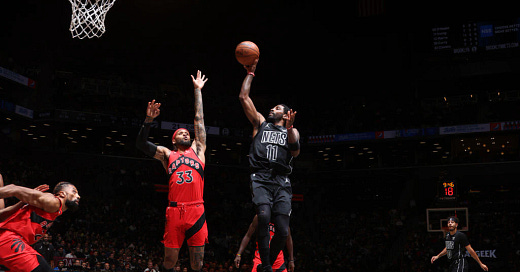Nets Take Cue From Irving’s Early Pace In Pummeling Raptors
Kyrie Irving came out of the tunnel with a spring in his step at the start of the Nets’ 114-105 wire-to-wire victory over Toronto on Friday night at Barclays Center.
Whether it was because he was excited about the return to action of new teammate T.J. Warren after the forward was forced to sit out two years due to foot woes or that he has simply worn off all the rust from missing eight games while serving a suspension for promoting hateful and antisemitic content on his social media, Brooklyn’s superstar guard played spectacularly, efficiently, and, when he saw opportunities to put the pedal to the metal, with pace.
Whereas Irving entered the contest with a shot profile that skewed heavily toward perimeter jump shots (just 37.6% of his field goal attempts were taken from inside the paint, per NBA.com’s tracking), he was in attack mode more often instead of settling for hero-ball home runs. Against the lengthy and athletic Raptors lineup, Irving went 7-for-9 from inside 15 feet.
The Nets took their cue from Irving (and yes, that was a good thing), who finished with 27 points, 5 rebounds, 5 assists, and 2 steals. Before Brooklyn took the air out of the ball in the second half, it was popping (19 assists at intermission) and the pace was 4% higher in terms of average number of possessions per game, per NBA.com. The Nets even managed to stay close to Toronto in the board battle (43-41).
Usually you think of the Raptors when it comes to transition proficiency (they averaged a league-leading 18.8 fast break points per game entering the contest), yet it was Brooklyn who owned an 18-8 advantage in the category, including a 14-6 margin in a first half that saw the Nets go up by as many as 36 points before they took their foot off the gas.
Give some credit here to Edmond Sumner, Brooklyn’s leader in fast break points per 36 minutes, as well. On a team that relies a ton on jump shots in the half-court, Sumner’s exceptional speed and ability to finish at the rim stand out. He’s shooting 63% from inside the restricted area this season--about the same as Irving, who is generally regarded as one of the best ever at it among smaller players. Plus, he can man up full-court to frustrate ballhandlers—his pickpocket of Scottie Barnes in the last minute of the first quarter goaded the Raptors young forward into committing a flagrant foul on the ensuing breakaway layup attempt, which put the Nets up 39-17 after the free throw. Like I’ve written before, if Sumner could ever get his three-point shot to a consistent mid-30s range, he’d be an eight-figure player instead of one on a partially guaranteed contract.
Of course, this being the Nets, just as Warren was making his triumphant debut, scoring 10 points in 17 minutes, Sumner was forced to leave the contest during the third quarter with what was reported as a glute contusion. Vaughn joked after the game that reporters should tell Sumner not to fall to the ground so often after his layups.
For Irving, this season has hardly been a laughing matter. His behavior cost himself considerable money (and could possibly affect his next contract as a free agent after the season), and he hasn’t exactly embraced his coaches, be it Steve Nash, who was ousted after seven games, or Vaughn. Irving has been seen ignoring play calls from the sideline to instead go at it on his own and his effort on defense can most charitably be described as inconsistent.
Still, Irving is a unique talent, and it isn’t a stretch to believe that his uptick in performance (24 ppg on 50/38.5/77.8 shooting split) and the Nets’ four-game winning streak are related. On a night where buddy Kevin Durant was mostly held in check (17 points) by a buffet of exotic Toronto defenses, it was Irving who took charge when the Nets built their insurmountable lead.
_______________________________________________________________________
I would be remiss to ignore the Nets’ defense, which held a fully-loaded Raptors squad to 104 points per 100 possessions, about eight points lower than their average. All the pressure that Brooklyn’s immensely gifted group can put on opponents is predicated on them getting stops. The effort trailed off after the Nets built a big lead, but that is common in the NBA. Since Vaughn took over the bench on November 1, the Nets are fourth in the league in defensive efficiency over 17 games. Who would have thunk that?
In case you missed my last post (Nets’ Defensive Improvement In Run To Inch Over .500 Abetted By Foul Ball (substack.com)), the tell that signified how engaged the Nets were defensively was their foul total. For a ninth consecutive game, Brooklyn was out-attempted at the free throw line on Friday night (30-22) and committed an excessive 27 fouls.
Sometimes, that’s not a good thing (Do you have any clue what you’re supposed to be doing on defense, Cam Thomas?) and it led to the ejection of wing Joe Harris just as he was breaking out of his shooting slump. But most of Friday’s fouls were simply the Nets battling—contesting shots, hanging with mismatches off switches. fighting for rebounding position, etc.--and not the result of miscommunication breakdowns.
Better that than if they gave Toronto an untenable number of uncontested looks from the paint and behind the three-point line, right?



